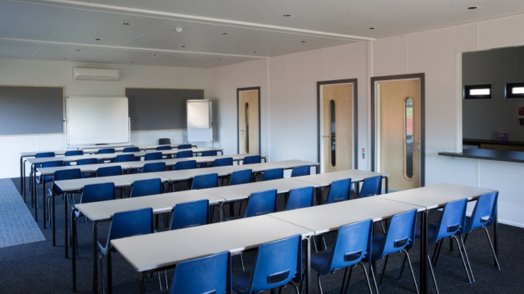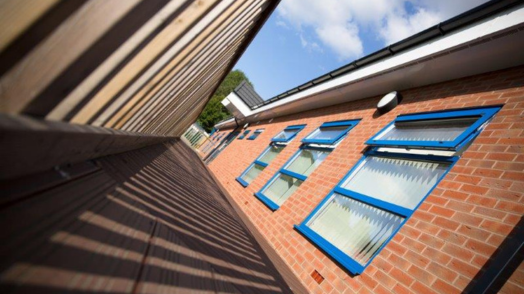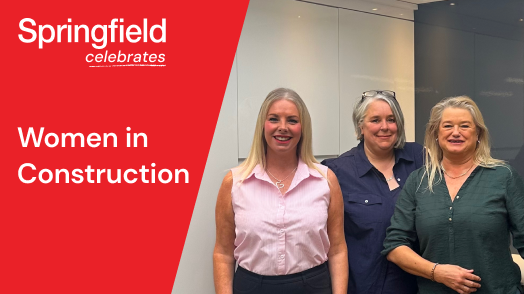Contact our friendly team for more information on our full range of buildings and how to start the process of hiring or buying a modular building for your business. Our expert team is always available to give advice, guidance or support.
Published: 20 February 2025 in Sectors
Education: Is Your School Ready for Expansion in 2025?

As schools across the UK begin reviewing enrolment projections for the 2025 academic year, many are facing a familiar challenge: accommodating a growing student population within existing facilities.
In 2022/23 the DFE announced that over 17% of primary schools and 23% of secondary schools are already over capacity, the need to plan for additional classroom space is therefore compelling. State secondary pupil numbers have been rising since 2016 with the rise becoming steeper since 2019. This upward trend is projected to continue until 2027.
Traditional construction methods, however, can be time-consuming, expensive, and disruptive. This is where modular classrooms provide a practical and cost-effective solution. By offering flexible, high-quality learning environments with minimal disruption, modular buildings are becoming the go-to choice for school expansions.
Understanding Your School’s Expansion Needs
Reviewing Enrolment Projections
Schools are currently in the process of assessing their enrolment numbers for the next academic year. As student numbers continue to rise, many institutions are finding that their existing classrooms are no longer sufficient.
Accurate enrolment projections help schools determine whether they will need additional classroom space in 2025. Factors influencing these projections include:
- New housing developments in the local area
- Increased birth rates leading to larger intakes
- Changes in catchment areas
- School closures or consolidations
Assessing Existing Classroom Capacity
Once enrolment projections have been reviewed, schools need to assess their current infrastructure. Key questions to consider include:
- Do we have enough classrooms to accommodate our projected student numbers? In 2024, concerns about school capacity were highlighted in various reports. Dozens of councils in England reported that state schools were already oversubscribed in certain year groups, raising concerns about the ability to manage increased demand. Specific year groups such as Years 7 and 8 exhibited less capacity, making them particularly strained.
- Are our existing classrooms fit for purpose, or do they need refurbishment? In December 2024 a Guardian investigation revealed that more than 1.5 million children are studying in dilapidated school buildings, with years of underinvestment impacting children’s education experience.
- Can we repurpose any existing space, or is additional construction necessary? In 2024, the UK government allocated over £17 billion since 2015 for maintaining and improving school conditions, including £1.8 billion for the 2024-25 financial year. This funding aimed to help schools assess and address their infrastructure needs, potentially allowing for the repurposing of existing spaces or the necessity of additional construction.
- How can we expand with minimal disruption to students and staff? To minimise disruption during expansions, many schools have considered modular construction methods. Modular classrooms can be constructed off-site and installed quickly, reducing on-site construction time and minimising interference with daily school activities. This approach allows for efficient expansion while maintaining a conducive learning environment.
If additional space is required, schools must consider their options carefully; balancing cost, construction time, and long-term sustainability.
Why Modular Classrooms Are the Ideal Expansion Solution
Modular classrooms provide an efficient and cost-effective way for schools to expand their facilities. Unlike traditional construction, modular buildings are prefabricated in a factory setting and assembled on-site, significantly reducing disruption to the school environment.
- Rapid Construction Time
Traditional construction can take months – or even years – to complete. In contrast, modular classrooms can be built and installed in a matter of weeks. Since much of the work is done off-site, site preparation and module fabrication occur simultaneously, cutting down the overall timeline. This means that schools can have new classrooms ready for the start of the academic year without delays.
- Minimal Disruption to Learning
One of the biggest challenges of school expansion is managing construction work without disrupting students and staff. With traditional building methods, schools often face noise, safety concerns, and limited access to outdoor spaces. Modular construction eliminates much of this disruption, as most of the work is completed off-site.
- Cost-Effective Expansion
Budget constraints are a major consideration for schools, and modular classrooms provide an affordable alternative to traditional construction. The controlled factory environment reduces waste, improves efficiency, and lowers overall costs. Additionally, modular buildings require fewer on-site labour hours, further reducing expenses.
- Flexible and Scalable
Modular classrooms are not just a short-term fix; they offer long-term flexibility. Schools can start with a single modular unit and expand as needed, allowing them to scale their facilities in response to changing student numbers. Additionally, modular buildings can be repurposed for other uses, such as offices, storage, or specialised learning spaces.
- Environmentally Friendly
Sustainability is an increasing priority for schools, and modular classrooms align with green building practices. Benefits include:
- Reduced material waste: Precise factory construction minimises excess materials.
- Lower carbon footprint: Fewer site deliveries and less energy-intensive processes reduce environmental impact.
- Energy-efficient features: Modular classrooms can be designed with energy efficient processes, LED lighting, and superior insulation to improve overall energy efficiency.
- No Planning Permission Hassles
Schools often worry about planning permission when expanding their facilities. While modular classrooms typically require approval, providers like Springfield offer full turnkey services, handling the entire process from application to installation.
Planning for a Smooth Modular Classroom Installation
If your school is considering modular classrooms for expansion in 2025, here’s what to expect from the process:
- Consultation and Design
Work with a modular building provider to assess your needs and create a custom design. Modular classrooms can be tailored to include:
- Interactive learning spaces
- Open-plan or partitioned designs
- Specialised rooms for science, art, or music
- Factory Construction and Site Preparation
While your modular classrooms are being built in a factory, groundwork preparation – including foundations and utility connections – can be completed on-site.
- Transportation and Installation
Once the modules are ready, they are transported to the school and assembled quickly, often within a few days.
- Final Touches and Handover
Interior and exterior finishes are applied, followed by inspections to ensure safety and compliance. Once completed, the building is ready for use.
Is Your School Ready for Expansion in 2025?
With rising enrolment numbers and increasing pressure on school facilities, now is the time to assess your school’s readiness for expansion. Modular classrooms provide a practical, cost-effective, and sustainable solution—helping schools accommodate growing student populations without the challenges of traditional construction.
If your school needs additional space for 2025, contact Springfield today to discuss how modular classrooms can meet your requirements. Our expert team can guide you through the process, from planning to installation, ensuring a smooth and hassle-free expansion.
Future-Proof Your School with Modular Classrooms – Plan Your Expansion Today!
With over 50 years of experience, we’re here to help schools create environments where all children can thrive. Contact Springfield to discover how we can help your school with its expansion plans for 2025.








